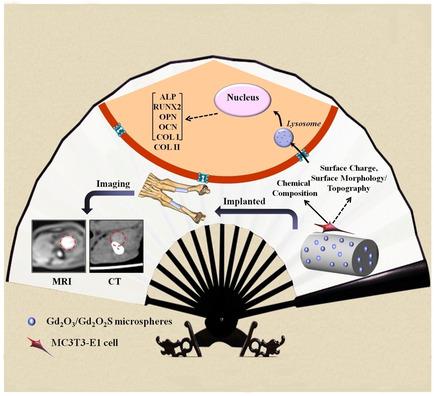当前位置:
X-MOL 学术
›
ChemNanoMat
›
论文详情
Our official English website, www.x-mol.net, welcomes your
feedback! (Note: you will need to create a separate account there.)
Incorporation of Gadolinium Oxide and Gadolinium Oxysulfide Microspheres: MRI/CT Monitoring and Promotion of Osteogenic/Chondrogenic Differentiation for Bone Implants
ChemNanoMat ( IF 2.6 ) Pub Date : 2020-11-10 , DOI: 10.1002/cnma.202000476 Jing Huang 1 , Zhaoyun Tang 2 , Min Guo 3 , Yu Wang 3 , Zongliang Wang 3 , Zhenxu Wu 3 , Peibiao Zhang 3
ChemNanoMat ( IF 2.6 ) Pub Date : 2020-11-10 , DOI: 10.1002/cnma.202000476 Jing Huang 1 , Zhaoyun Tang 2 , Min Guo 3 , Yu Wang 3 , Zongliang Wang 3 , Zhenxu Wu 3 , Peibiao Zhang 3
Affiliation

|
The current biodegradable polymer materials, as orthopedic implants, can not be traced timely by using the existing medical imaging techniques due to low density and lack of relaxed hydrogen proton ability. Considering the paramagnetism of gadolinium and the particularity of micro/nano materials, we synthesized inorganic gadolinium oxide and gadolinium oxysulfide microspheres with regular morphology and uniform size without doped rare earth. After incorporation into biodegradable polymer of poly(lactic‐co‐glycolic acid), their effects on signals of MRI, CT and osteogenic/chondrogenic differentiation were investigated to acquisition of multifunctional micro/nano composites for bone implants. At the studied concentrations, gadolinium oxide microspheres showed higher signal than gadolinium oxysulfide microspheres on T1‐weighted imaging. Both of them were of fine biocompatibility and did not show their negative effect on adhesion and proliferation in the concentration of 0.4% (w/w, Gd/PLGA). Meanwhile, the osteogenic/chondrogenic differentiation of MC3T3‐E1 preosteoblasts, including ALP activity, calcium deposition and expression of Runx2, OPN, OCN, COL I and COL II in mRNA and protain, were stimulated at different level, which indicated that moderate use the inorganic gadolinium oxide and gadolinium oxysulfide microspheres could realize the function of tracing the polymer bone implants by MRI/CT and inducing the osteogenic/chondrogenic differentiation simultaneously.
中文翻译:

氧化Ox和氧化硫Ga微球的整合:骨植入物的MRI / CT监测和成骨/成骨分化的促进
由于低密度和缺乏松弛的氢质子能力,不能通过使用现有的医学成像技术及时追踪作为骨科植入物的当前可生物降解的聚合物材料。考虑到the的顺磁性和微/纳米材料的特殊性,我们合成了形态规则,尺寸均匀,未掺杂稀土的无机氧化oxide和氧硫化g微球。将聚乳酸-乙醇酸共聚物掺入生物可降解聚合物后,研究了它们对MRI,CT信号和成骨/软骨形成分化的影响,从而获得了用于骨植入物的多功能微/纳米复合材料。在所研究的浓度下,氧化micro微球在T 1上显示出比氧硫化g微球更高的信号加权成像。它们都具有良好的生物相容性,并且在浓度为0.4%(w / w,Gd / PLGA)时未显示出它们对黏附和增殖的负面影响。同时,在不同水平上刺激了MC3T3-E1前成骨细胞的成骨/软骨分化,包括ALP活性,钙沉积以及Runx2,OPN,OCN,COL I和COL II在mRNA和蛋白中的表达,这表明适度使用无机氧化oxide和氧硫化g微球可以实现通过MRI / CT追踪聚合物骨植入物并同时诱导成骨/软骨分化的功能。
更新日期:2020-12-07
中文翻译:

氧化Ox和氧化硫Ga微球的整合:骨植入物的MRI / CT监测和成骨/成骨分化的促进
由于低密度和缺乏松弛的氢质子能力,不能通过使用现有的医学成像技术及时追踪作为骨科植入物的当前可生物降解的聚合物材料。考虑到the的顺磁性和微/纳米材料的特殊性,我们合成了形态规则,尺寸均匀,未掺杂稀土的无机氧化oxide和氧硫化g微球。将聚乳酸-乙醇酸共聚物掺入生物可降解聚合物后,研究了它们对MRI,CT信号和成骨/软骨形成分化的影响,从而获得了用于骨植入物的多功能微/纳米复合材料。在所研究的浓度下,氧化micro微球在T 1上显示出比氧硫化g微球更高的信号加权成像。它们都具有良好的生物相容性,并且在浓度为0.4%(w / w,Gd / PLGA)时未显示出它们对黏附和增殖的负面影响。同时,在不同水平上刺激了MC3T3-E1前成骨细胞的成骨/软骨分化,包括ALP活性,钙沉积以及Runx2,OPN,OCN,COL I和COL II在mRNA和蛋白中的表达,这表明适度使用无机氧化oxide和氧硫化g微球可以实现通过MRI / CT追踪聚合物骨植入物并同时诱导成骨/软骨分化的功能。









































 京公网安备 11010802027423号
京公网安备 11010802027423号